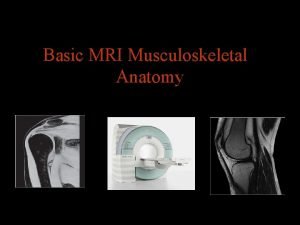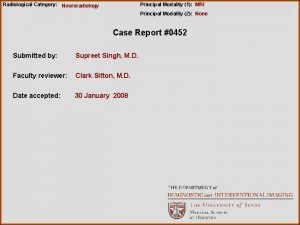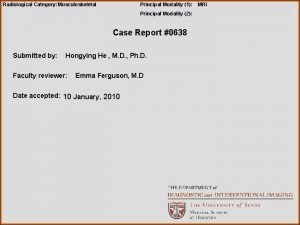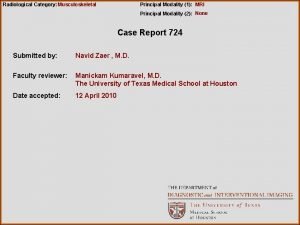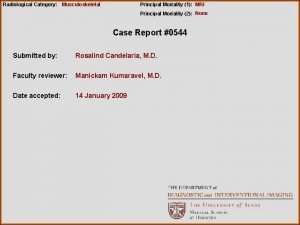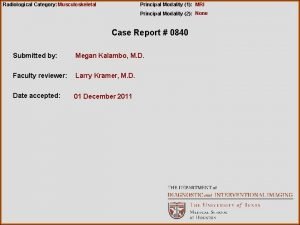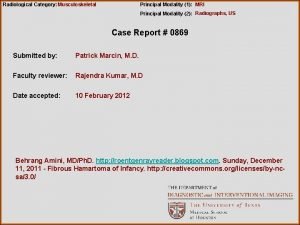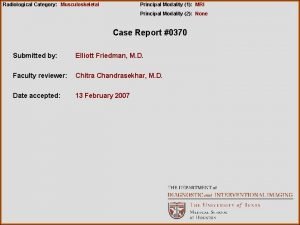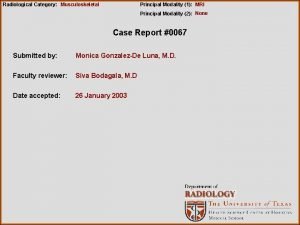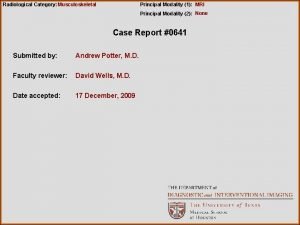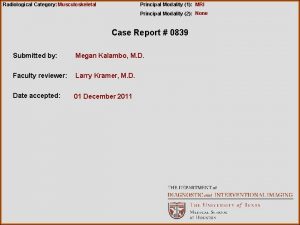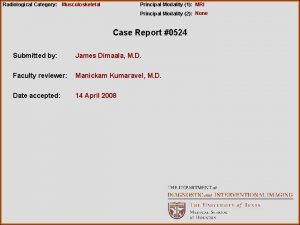Radiological Category Musculoskeletal Principal Modality 1 MRI Principal












- Slides: 12

Radiological Category: Musculoskeletal Principal Modality (1): MRI Principal Modality (2): General Radiography Case Report #0573 Submitted by: Nicholas Beckmann, M. D. Faculty reviewer: Michael Redwine, M. D. Date accepted: 15 February 2009

Case History 62 -year-old female with chronic left knee pain.

Plain Films AP Lateral

Coronal MRI w/o contrast T 1 T 2 Fat Sat

Coronal MRI w/o contrast T 1 T 2 Fat Sat

Sagittal MRI w/o contrast T 1 T 2

Test Your Diagnosis Which one of the following is your choice for the appropriate diagnosis? After your selection, go to next page. • Pigmented Villonodular Synovitis • Lipoma Arborescens • Synovial Chondromatosis

Findings and Differentials Findings: Plain radiographs: Severe degenerative changes of the left knee, greatest in the medial compartment. There is joint space narrowing with osteophyte formation at the joint margins and subchondral cyst formation. A moderate-to-large suprapatellar joint effusion and/or synovial proliferation is present. MRI: There is a moderate joint effusion with extensive proliferation of lipomatous synovium in the suprapatellar recess of the joint. Extensive degenerative changes as seen on the plain radiographs are again noted. In addition, extrusion of the medial meniscus is present. Differentials: • Lipoma arborescens • Synovial Chondromatosis • Pigmented Villonodular Synovitis

Discussion Lipoma Arborescens: Rare benign condition that typically occurs in the 5 th to 7 th decades of life. It is characterized by replacement of subsynovial tissues by mature fat cells and represents a nonspecific reaction to trauma or inflammation. It is typically monarticular and is seen to occur most commonly in the suprapatellar recess of the knee. Patients most commonly present with long standing joint pain. Diagnosis can be made on MRI as the fatty proliferation exhibits the same signal as subcutaneous fat on all sequences. It is frequently seen in association with osteoarthritic degenerative changes. Synovial Chondromatosis: Benign condition typically occuring between 3 rd and 5 th decades of life. Occurs in men twice as commonly as women. It is characterized by synovial proliferation resulting in formation of cartilaginous intra-articular loose bodies. Over time, these cartilaginous nodules may calcify. This condition is also monarticular and most commonly seen in the knee. Patients typically present with joint pain and limited joint motion. Patients typically have joint effusion or fullness on plain film. Marginal erosions at the joint may occur. Secondary arthritic changes are usually a late findings after longstanding presence of intra-articular loose bodies. Non-calcified cartilage loose bodies are typically isointense to muscle on T 1 imaging and hyperintense on T 2. Areas of calcification will be low signal on T 1 and T 2.

Discussion Pigmented Villonodular Synovitis: Benign proliferative disorder of the synovium that typically occurs in young to middle-aged adults. It typically will diffusely affect the joint, although, focal involvement of the joint can occur. It is almost always monarticular, and the knee joint is the most common joint involved. Plain films usually only show joint fullness or soft tissue swelling. There will commonly be areas of high T 2 signal in the joint secondary to inflamed synovium. The synovium also tends to bleed easily, leading to hemosiderin deposition. The hemosiderin produces areas within the joint that are low signal on all pulse sequences, which is characteristic of this condition.

Diagnosis Lipoma arborescens with association severe osteoarthritic changes.

References Monu J. “Pigmented Villonodular Synovitis”. Emedicine. com. June 21, 2007 Monu J, Oka M. “Synovial Osteochondromatosis”. Emedicine. com. June 21, 2007 Murphey MD, et al. “From the Archives of the AFIP: Benign Musculoskeletal Lipomatous Lesions”. Radiographics. 2004; 24: 1433 -1466 Ryu KN, et al. “MR Imaging of Lipoma Arborescens of the Knee Joint”. AJR. 1996; 167: 1229 -1232 Sheldon PJ, et al. “Imaging of Intraarticular Masses”. Radiographics. 2005; 25: 105 -119
 Mri
Mri Erate category 1
Erate category 1 Radiological dispersal device
Radiological dispersal device Tennessee division of radiological health
Tennessee division of radiological health Center for devices and radiological health
Center for devices and radiological health National radiological emergency preparedness conference
National radiological emergency preparedness conference Mri principal
Mri principal Cardinality and modality
Cardinality and modality Modality erd
Modality erd Modality in software engineering
Modality in software engineering Epistemic modality
Epistemic modality Birads staging
Birads staging Modality in statistics
Modality in statistics
